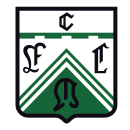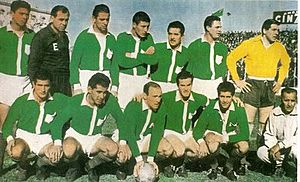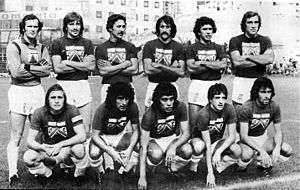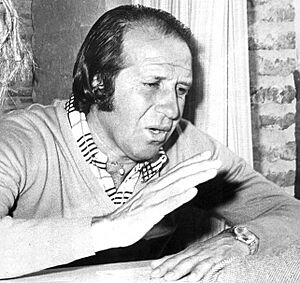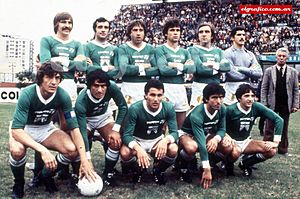Ferro Carril Oeste facts for kids
Ferro Carril Oeste, often called Ferro, is a famous sports club from Caballito, Buenos Aires, Argentina. While it offers many activities, it's best known for its football (soccer) team. This team plays in the Primera Nacional, which is the second-highest football league in Argentina.
Ferro Carril Oeste offers a wide range of sports. You can play athletics, basketball, baseball, futsal, handball, field hockey, swimming, taekwondo, tennis, table tennis, and volleyball. Since 2001, the club has also hosted professional boxing events.
The club's name, "Ferro Carril Oeste," means "Western Railway." It was started in 1904 by people who worked for the Buenos Aires Western Railway. The 1980s were a "golden age" for Ferro. The club won many titles in different sports. Unesco even recognized it as a great example of a sports institution. During those years, Ferro Carril Oeste had 50,000 members!
History
The Beginning of Ferro
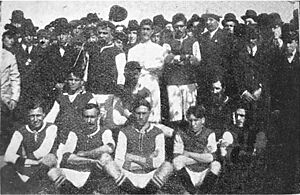
Ferro Carril Oeste has always been located in the Caballito neighborhood. It was founded on July 28, 1904. About 100 employees of the Buenos Aires Western Railway started the club. The railway managers supported the club. This helped Ferro get land to build its main offices and sports areas quickly.
In 1905, the club built its own stadium, Estadio Arquitecto Ricardo Etcheverry. David Simpson, a key founder, helped pay for it. Ferro joined the Argentine Football Association to play in the third division.
The first official football match was on April 21, 1907, against River Plate. In 1912, Ferro won the División Intermedia title. This was the second division at the time. This win helped them move up to the Primera División, the top league. That same year, the club also won the Copa Bullrich title. Ferro won another Copa Bullrich title the next year, but with their reserve teams.
Ferro played its first top-division match in 1913 against Riachuelo, which ended in a 1–1 tie. Around this time, the club also opened running tracks, bocce courts, tennis courts, and basque pelota courts. However, they closed their cricket section in 1914.
The Five Musketeers Era
By the late 1930s, the club became independent from the railway company. It changed its name to "Club Ferro Carril Oeste." In 1937, five very talented young players came from the club's youth teams. They were known as The Five Musketeers because they were so good at attacking. These players were Bernardo Gandulla, Juan José Maril, Luis Borgnia, Jaime Sarlanga, and Raúl Emeal.
These skilled players only played together in 1937 and 1938. Other clubs soon bought them. For example, Sarlanga had a great career with Boca Juniors. Gandulla and Sarlanga together scored more than half of Ferro's goals in the 1937 season.
Another important player for the club was Delfín Benítez Cáceres. He played from 1941 until he retired in 1944, scoring 20 goals. Gandulla and Emeal came back to Ferro in 1944 after playing for Boca Juniors. Even with these great players, Ferro finished last in 1946. This meant they were moved down to Primera B for the first time.
Besides football, the club added more sports. These included swimming, water polo, and chess. In 1933, Ferro formed its first basketball team. In the 1940s, Ferro also added fencing and roller skating. Because of all these new sports, the number of club members grew. By 1941, there were more than 6,000 members.
From 1950 to 1970
Ferro quickly returned to the first division in 1949. They won the Primera B title that year. Atilio Renzi, a politician, was the club president then. During his time, volleyball was added to the club's sports. The football team stayed in the top league until 1957. Their poor performance that year caused Ferro to be moved down for the second time.
Ferro only stayed in Primera B for one year. They returned in 1958 after winning the championship. Ferro earned 50 points in 34 matches, beating Nueva Chicago by four points.
In the 1959 Primera División, Ferro finished 4th. This was their best finish in the top league up to that point. After being moved down again, Ferro won the Primera B championship in 1963. This brought them back to the Primera División. In the top league, Ferro reached another 4th place in the 1965 tournament. Ferro was moved down again in 1968 after playing a special "Reclasificatorio" tournament. In the 1969 Primera B season, Ferro won the tournament. However, they could not move up to Primera after losing to Banfield and Deportivo Morón in the Reclasificatorio tournament.
Following their good performance in 1969, Ferro C.O. won its second Primera B title in a row in 1970. This allowed them to move directly to the Primera División for the 1971 season. By 1972, the club had 17,299 members. They also opened the Gimnasio Héctor Etchart, which is the home for the basketball team. In 1974, Ferro wore an orange jersey. This was a tribute to the Netherlands national football team, known as The Clockwork Orange, who were World Cup runners-up. Ferro finished 6th in the Torneo Nacional that year. Gerónimo Saccardi was one of the most important players for the club during these years. After some up-and-down seasons, Ferro finished last in 1977. They were moved down along with Lanús and Temperley.
Ferro C. Oeste quickly returned to Primera. The team won the Primera B championship in 1978.
The Golden Age: The 1980s
The 1980s were a very successful time for Ferro in Argentine sports. This was especially true for football and basketball. The football team won two Argentine Primera División titles. They also played in the Copa Libertadores, a major international tournament. The basketball team won the Liga Nacional de Básquet (Argentina's top basketball league) three times.
In 1979, Carlos Griguol became the club's manager. He became the most successful coach in Ferro's history. He won two Primera División titles, which were the club's first. He also helped develop great players like Alberto Márcico, Héctor Cúper, and Oscar Garré. In the 1981 Metropolitano championship, Ferro finished 2nd. They had 49 points, just one less than champion Boca Juniors. In that season, goalkeeper Carlos Barisio set a national record. He did not let any goals in for 1,075 minutes! This included 10 full games without giving up a goal. That same year, Ferro reached the Torneo Nacional final. However, they lost to River Plate in both matches (1–0 each).
Ferro finally won its first top-division title in 1982. They won the Nacional tournament by beating defending champions Quilmes in the finals (0–0, 2–0). The team played 22 matches in total. They won 16 and had 6 draws, meaning they won the championship without losing a single game. Ferro scored 50 goals and only let in 13. Left winger Miguel Angel Juárez was the top scorer with 22 goals. Other important players for the champion team were Adolfino Cañete, Alberto Márcico, Juan Domingo Rocchia, and Héctor Cúper.
Even though some key players from the 1982 tournament had left, Ferro won another Torneo Nacional in 1984. They beat River Plate (who had stars like Norberto Alonso and Enzo Francescoli) in both finals (3–0 and 1–0). The team played 14 matches, winning 8 and losing only 1, with 5 draws. Ferro scored 32 goals and only let in 9. Márcico was the top scorer with 5 goals. As one of Argentina's champions, Ferro played in the 1983 Copa Libertadores. They were in a group with Estudiantes LP and Chilean teams Colo Colo and Cobreloa. They were eliminated after finishing last in their group.
The team's good performance in local football continued in the 1984 Metropolitano. Ferro C.O. finished 2nd with 50 points, just behind Argentinos Juniors (51 points). Ferro returned to international competitions to play the 1985 Copa Libertadores. They were eliminated in the first stage.
During the 1980s, Ferro became famous not just for football but also for basketball. They were the first winners of the new Liga Nacional in 1985. They beat Atenas 2–1 in the finals. Santiago Leyden was the club president from 1964 to 1993. He is seen as the person who led the club to a decade of greatness. During his time, Ferro won over 100 titles in various sports. Leyden was also a vice president of CONMEBOL from 1976 to 1980. Also in the 1980s, Ferro Carril Oeste reached its peak as a sports and social club. It had over 50,000 members and was called a "model institution" by Unesco.
In 1987, Carlos Griguol left the club to coach River Plate. He had won two top-division titles for Ferro. These are still the only two championships Ferro has won at the top level of Argentine football. He also led them to two second-place finishes. Griguol returned in 1988 and coached Ferro until 1993.
Decline
Ferro also holds a record for the longest time without scoring a goal. The team went 875 minutes without scoring. This happened between the end of the 1998 Apertura and the 1999 Clausura tournaments.
In the 1990s, Ferro's performance slowly got worse. They were moved down to the third division in 2001 after two straight relegations. Ferro finally returned to the second division in 2003.
Ferro has a strong rivalry with Vélez Sársfield. Their matches are known as the Clásico del Oeste (Western Derby).
Kit Uniform Evolution
Main Uniform
|
Special Editions
|
- Notes
Players
Current Squad
|
|
Out on Loan
|
|
Notable Former Players
 Bernardo Gandulla (1934–39)
Bernardo Gandulla (1934–39) Jaime Sarlanga (1937–39)
Jaime Sarlanga (1937–39) Delfín Benítez Cáceres (1941–44)
Delfín Benítez Cáceres (1941–44) Vicente Gambardella (1960)
Vicente Gambardella (1960) Gerónimo Saccardi (1969–75, 1979–83)
Gerónimo Saccardi (1969–75, 1979–83) Juan Domingo Rocchia (1973–83)
Juan Domingo Rocchia (1973–83) Oscar Garré (1974–88)
Oscar Garré (1974–88) Héctor Cúper (1976–77, 1978–88)
Héctor Cúper (1976–77, 1978–88) Carlos Barisio (1978–83)
Carlos Barisio (1978–83) Alberto Márcico (1980–85)
Alberto Márcico (1980–85) Adolfino Cañete (1980–84)
Adolfino Cañete (1980–84) Carlos Moya
Carlos Moya
Managers
 Mario Fortunato (1937), (1953)
Mario Fortunato (1937), (1953) Pedro Dellacha (1965)
Pedro Dellacha (1965) Victorio Spinetto (1973–76)
Victorio Spinetto (1973–76) Carlos Griguol (1979–87), (1988–93)
Carlos Griguol (1979–87), (1988–93) Gerónimo Saccardi (1997–99)
Gerónimo Saccardi (1997–99) Rubén Darío Insúa (1999)
Rubén Darío Insúa (1999) Héctor Rivoira (2004–05)
Héctor Rivoira (2004–05) José Luis Brown (2007–08)
José Luis Brown (2007–08) Carlos Trullet (2008–09)
Carlos Trullet (2008–09) Jorge Luis Ghiso (2009)
Jorge Luis Ghiso (2009) Dalcio Giovagnoli (2010)
Dalcio Giovagnoli (2010) Mario Gómez (2011–12)
Mario Gómez (2011–12) José Luis Brown (2013)
José Luis Brown (2013) José Romero (2014)
José Romero (2014) Marcelo Broggi (2015)
Marcelo Broggi (2015) Walter Perazzo (2016)
Walter Perazzo (2016) Marcelo Broggi (2017–18)
Marcelo Broggi (2017–18) Alejandro Orfila (2018)
Alejandro Orfila (2018) Jorge Cordon (2018–20)
Jorge Cordon (2018–20) Diego Osella (2020-)
Diego Osella (2020-)
Honours
League Titles
- Primera División (2): 1982 Nacional, 1984 Nacional
- Primera División B (5): 1958, 1963, 1969, 1970, 1978
- División Intermedia (1): 1912
- Primera B Metropolitana (1): 2002–03
Cup Titles
- Copa Bullrich (2): 1912, 1913
Friendly Titles
- Copa El Diario (1): 1908
Other Sports
Basketball Success
Ferro Carril Oeste was one of Argentina's most successful basketball clubs in the 1980s. They were the first champions of the Liga Nacional de Básquet in 1985. The club has won three LNB titles and one Campeonato Argentino title.
On the international stage, Ferro won three South American Championship titles. They were also the first Argentine team to win this competition. Ferro remains one of the most winning Argentine teams, along with Boca Juniors.
2019–20 Ferro Carril Oeste season
Volleyball Achievements
Men's Team Honours
- Primera División (6): 1977, 1980, 1981, 1983, 1984, 1985
- Copa Morgan (7): 1966, 1977, 1977, 1983, 1984, 1985, 1986
- Campeonato Sudamericano (2): 1987, 1998
Women's Team Honours
- Primera División (8): 1979, 1980, 1981, 1982, 1983, 1984, 1985, 1990
- Copa Morgan (11): 1977, 1978, 1980, 1981, 1983, 1984, 1986, 1987, 1988, 1998, 2004
See also
 In Spanish: Club Ferro Carril Oeste para niños
In Spanish: Club Ferro Carril Oeste para niños


